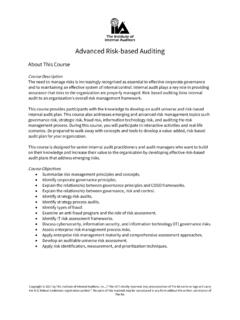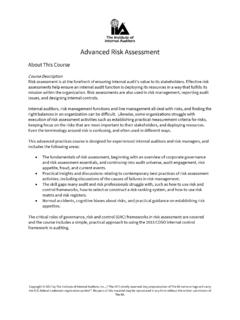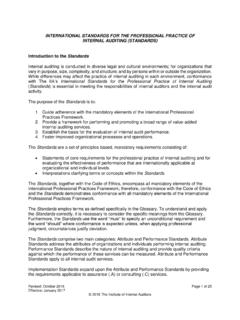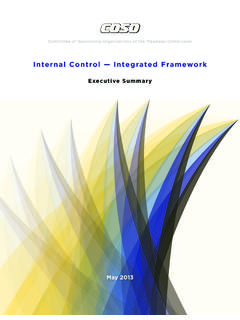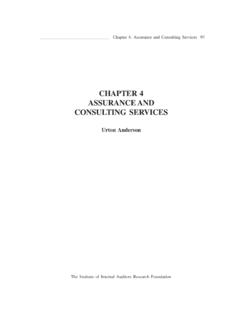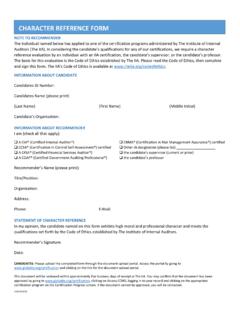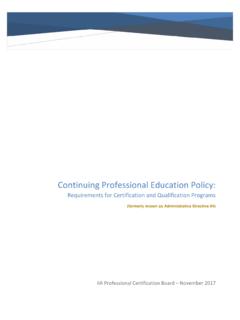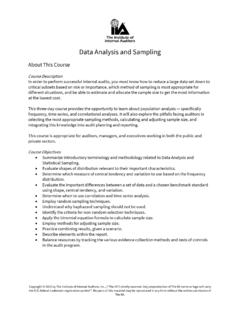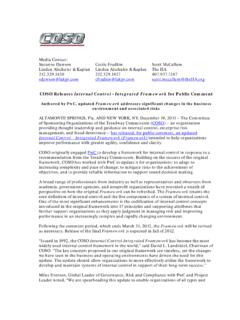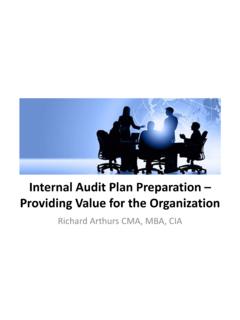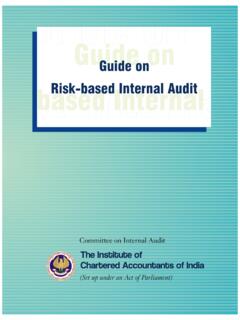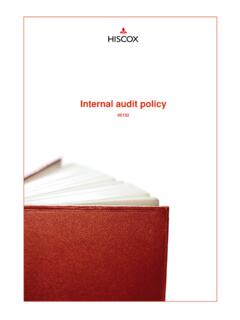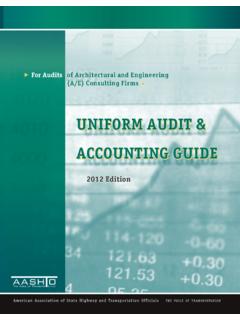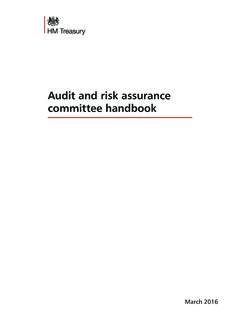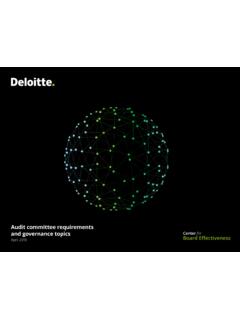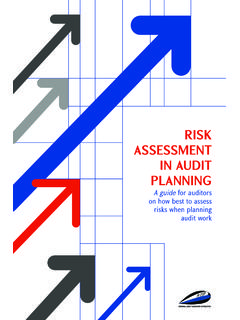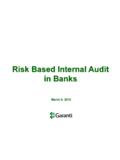Transcription of Effective Internal Audit in the Financial Services Sector
1 Effective Internal Audit in the Financial Services SectorRecommendations from the Committee on Internal Audit Guidance for Financial Services : How They Relate to the Global Institute of Internal Auditors (The IIA) International Standards for the Professional Practice of Internal Auditing (Standards)The Standards mapped to the recommendationsSeptember 20132 ContentsIntroduction 3 How the Global IIA Standards Relate to the Financial Services Committee Recommendations: Definition of Internal Auditing 4 1000 Purpose, Authority, and Responsibility 4 1100 Independence and Objectivity 5 1110 Organizational Independence 5 1111 Direct Interaction with the Board 8 1130 Impairment to Independence or Objectivity 8 1210 Proficiency 8 1230 Continuing Professional Development 9 1300 Quality Assurance and Improvement Program.
2 Interpretation 9 1310 Requirements of the Quality Assurance and Improvement Program 10 1311 Internal Assessments 11 1312 External Assessments 11 1320 Reporting on the Quality Assurance and Improvement Program 12 2010 Planning 13 2020 Communication and Approval 13 2030 Resource Management 14 2040 Policies and Procedures 14 2050 Coordination 15 2060 Reporting to Senior Management and the Board 15 2070 External Service Provider and Organizational Responsibility for Internal Auditing 16 2100 Nature of Work 16 2110 Governance 17 2120 Risk Management 18 2130 Control 20 2400 Communicating Results 20 2440 Disseminating Results 203 In July, 2013, the Chartered Institute of Internal Auditors (the Chartered Institute), the UK and Ireland affiliate of The IIA, published Effective Internal Audit in the Financial Services Sector .
3 The publication offers recommendations on how to enhance Internal Audit in the UK Financial Services Sector as an additional benchmark against which firms can measure their Internal Audit function . It aims to build on the IIA International Standards. The recommendations were made directly to the Chartered Institute by an Independent Committee comprised of noted board directors, Internal Audit professionals, and academicians, and included observers from the UK Financial Services regulators (the Financial Conduct Authority and the Prudential Regulation Authority) and corporate governance regulator ( Financial Reporting Council).The recommendations are based on the mandatory elements of the IIA s International Professional Practices Framework (IPPF), which comprise the: Definition of Internal Auditing, Code of Ethics, and International Standards for the Professional Practice of Internal Auditing (Standards)While the Standards outline what Internal auditors must do, and are mandatory for all Internal auditors who are members of The IIA, the recommendations of the Independent Committee are intended to provide additional guidance to all Financial Services Internal auditors, as well as their companies boards and executive managements.
4 The recommendations supplement the Standards, but are neither mandatory nor strongly recommended guidance of the IPPF. The IIA supports and appreciates the work of the Independent Committee and believes the Committee has provided thoughtful recommendations for Financial Services Internal Audit functions operating in the UK to consider. The applicability of these recommendations should be viewed in that order to illustrate the relationship between the Standards and the recommendations of the Independent Committee, the Chartered Institute and The IIA have jointly prepared documents demonstrating how relevant components of the Standards relate to the individual recommendations.
5 In this version it maps the relevant Standards to the recommendations. A companion document has also been produced presenting how the individual recommendations map to the the Global IIA Standards Relate to the Financial Services Committee RecommendationsDefinition of Internal Auditing Internal auditing is an independent, objective assurance and consulting activity designed to add value and improve an organization s operations. It helps an organization accomplish its objectives by bringing a systematic, disciplined approach to evaluate and improve the effectiveness of risk management, control, and governance Purpose, Authority, and ResponsibilityThe purpose, authority, and responsibility of the Internal Audit activity must be formally defined in an Internal Audit charter, consistent with the Definition of Internal Auditing, the Code of Ethics, and the Standards.
6 The chief Audit executive must periodically review the Internal Audit charter and present it to senior management and the board for :The Internal Audit charter is a formal document that defines the Internal Audit activity s purpose, authority, and responsibility. The Internal Audit charter establishes the Internal Audit activity s position within the organization, including the nature of the chief Audit executive s functional reporting relationship with the board; authorizes access to records, personnel, and physical properties relevant to the performance of engagements; and defines the scope of Internal Audit activities. Final approval of the Internal Audit charter resides with the board.
7 1. The primary role of Internal Audit should be to help the Board and Executive Management to protect the assets, reputation and sustainability of the organisation. It does this by assessing whether all significant risks are identified and appropriately reported by management and the Risk function to the Board and Executive Management; assessing whether they are adequately controlled; and by challenging Executive Management to improve the effectiveness of governance, risk management and Internal controls. The role of Internal Audit should be articulated in an Internal Audit Charter, which should be publicly available. 1. The primary role of Internal Audit should be to help the Board and Executive Management to protect the assets, reputation and sustainability of the organisation.
8 It does this by assessing whether all significant risks are identified and appropriately reported by management and the Risk function to the Board and Executive Management; assessing whether they are adequately controlled; and by challenging Executive Management to improve the effectiveness of governance, risk management and Internal controls. The role of Internal Audit should be articulated in an Internal Audit Charter, which should be publicly available. 14. Internal Audit should have sufficient and timely access to key management information and a right of access to all of the organisation s records, necessary to discharge its responsibilities. In organisations in which the Internal Audit function is outsourced, the Chair of the Audit Committee should identify an appropriate individual responsible for ensuring that the Chief Internal Auditor has sufficient and timely access to key management information and StAnDARDSR ecommenDAtIonS of the InDePenDent commIttee51100 Independence and objectivityThe Internal Audit activity must be independent, and Internal auditors must be objective in performing their :Independence is the freedom from conditions that threaten the ability of the Internal Audit activity to carry out Internal Audit responsibilities in an unbiased manner.
9 To achieve the degree of independence necessary to effectively carry out the responsibilities of the Internal Audit activity, the chief Audit executive has direct and unrestricted access to senior management and the board. This can be achieved through a dual-reporting relationship. Threats to independence must be managed at the individual auditor, engagement, functional, and organizational is an unbiased mental attitude that allows Internal auditors to perform engagements in such a manner that they believe in their work product and that no quality compromises are made. Objectivity requires that Internal auditors do not subordinate their judgment on Audit matters to others.
10 Threats to objectivity must be managed at the individual auditor, engagement, functional, and organizational levels. 1110 organizational IndependenceThe chief Audit executive must report to a level within the organization that allows the Internal Audit activity to fulfill its responsibilities. The chief Audit executive must confirm to the board, at least annually, the organizational independence of the Internal Audit :Organizational independence is effectively achieved when the chief Audit executive reports functionally to the board. Examples of functional reporting to the board involve the board: Approving the Internal Audit charter; Approving the risk based Internal Audit plan; 13.
